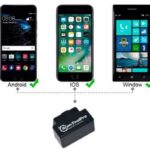On-Board Diagnostics (OBD) systems are crucial for monitoring vehicle health and emissions. This article delves into the critical differences between OBD1 and OBD2, outlining their functionalities and impact on vehicle maintenance.
A Brief History of OBD
OBD systems were introduced to monitor and control vehicle emissions. Initially implemented as OBD1 in the early 1990s, the system underwent a significant evolution with the introduction of OBD2 in 1996. This shift marked a standardization in diagnostics, benefiting both mechanics and vehicle owners.
Core Distinctions: OBD1 and OBD2
The primary difference between OBD1 and OBD2 lies in their scope and standardization. OBD1 systems, predominantly used until the mid-1990s, were manufacturer-specific, lacking uniformity in diagnostic connectors, protocols, and trouble codes. This variability made diagnostics challenging, requiring specialized equipment for each vehicle make and model.
Conversely, OBD2 introduced a standardized 16-pin diagnostic connector, communication protocol (Controller Area Network – CAN), and a universal set of Diagnostic Trouble Codes (DTCs). This standardization simplified diagnostics, allowing a single OBD2 scanner to be used across different vehicle makes and models. Furthermore, OBD2 expanded its monitoring capabilities beyond emissions to encompass various engine and transmission systems, enhancing overall vehicle diagnostics.
Data Coverage: Expanding the Scope of Diagnostics
OBD1 primarily focused on monitoring emissions-related components. OBD2, on the other hand, monitors a broader range of systems, including:
- Engine Performance: Ignition timing, fuel injection, and air/fuel ratios.
- Emissions Systems: Catalytic converter efficiency, oxygen sensor performance, and evaporative emissions.
- Transmission: Gear shifting, fluid pressure, and temperature.
- Anti-lock Braking System (ABS): Wheel speed sensors, hydraulic pressure, and control module function.
- Supplemental Restraint System (SRS): Airbag deployment system and seatbelt pretensioners.
Diagnostic Trouble Codes (DTCs): A Universal Language
OBD2 employs a standardized five-digit alphanumeric code system (DTCs) to identify specific malfunctions. These codes provide valuable insights into the nature and location of the problem, streamlining the diagnostic process for mechanics. This universal language enables quicker and more accurate repairs.
Beyond OBD2: EOBD and EOBD2
While OBD2 became the standard in North America, Europe adopted EOBD (European On-Board Diagnostics), largely mirroring OBD2 functionality. EOBD2, a more recent iteration, further refines emissions monitoring and diagnostic capabilities to meet stricter European regulations.
Benefits of OBD Systems
Both OBD1 and OBD2 contribute to:
- Reduced Emissions: Identifying and addressing malfunctions in emissions systems.
- Improved Fuel Economy: Detecting issues that impact fuel consumption.
- Enhanced Vehicle Maintenance: Providing data for preventative maintenance and timely repairs.
Conclusion
The evolution from OBD1 to OBD2 revolutionized vehicle diagnostics. OBD2’s standardization and comprehensive monitoring capabilities significantly improved the efficiency and accuracy of vehicle repairs, benefiting both mechanics and car owners. Understanding the differences between these systems provides valuable context for anyone involved in vehicle maintenance and repair.
